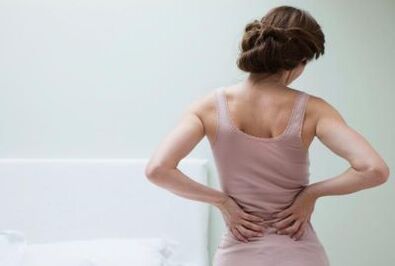
Low back pain can manifest in different ways. So, experts distinguish 4 main types of pain:
- Acute (lumbago) - pain in the lumbar spine caused by degenerative changes or previous injuries to the spine. Otherwise, the disease is called "lumbar lumbago". The pathology is characterized by severe discomfort in this area, which increases when performing any physical activity (sports activities, lifting weights, walking long distances, etc. ). Pulsating or shooting pain in the lumbar region often radiates to surrounding organs and tissues.
- Subacute or chronic (lumbodynia) - can be caused by lumbar osteochondrosis, scoliosis, dystrophic changes in the vertebrae and intervertebral discs, etc. or upright. Therefore, patients are forced to lie down or bend.
- Radiation in the legs (lumbosciatica) - painful sensations, fever or chills in the lower back and left or right leg. In this case, the pain spreads to the buttocks and increases with a change in body position.
- Severe neuropathic (radiculopathy or lumbosacral radiculitis) is pinching or damage to nerve roots and is characterized by sharp, piercing pain in one of the spines, constant tension in the back muscles, discomfort in the back of the thighs, tingling, burning and tingling. .
But for successful treatment it is necessary to know the causes of the appearance and development of pain. The specialists working in our center will perform the diagnosis easily and painlessly, after which they will prescribe the appropriate treatment.
Note! If you find yourself in any of the above types of pain, do not delay the visit to a doctor - vertebrologist, neurologist or chiropractor. Otherwise, your condition may worsen, leading to any complications.
Causes of pain
Low back pain occurs for a variety of reasons, ranging from inflammation of the muscles and bone marrow to diseases of the internal organs. Here are the main causes of lower back pain:
Degenerative-dystrophic processes
Degenerative-dystrophic processes cause the following pathologies:
- Osteochondrosis of the spine - degenerative changes occur when cracks appear in the intervertebral discs, as well as in the case of hernias in this area.
- Poor posture (including against the background of scoliosis) - in the absence of timely treatment, leads to frequent back pain.
- Overexertion or severe hypothermia of the muscles in the lumbar region - the pain is pulling and limiting in nature (a person can not straighten his back for a long time).
- Spondylolisthesis - the disease involves displacement of the lumbar vertebrae.
Inflammatory processes

Inflammatory processes also lead to discomfort in the lumbar region:
- Muscle inflammation (myositis) - occurs in various bacterial and viral infections.
- Ankylosing spondylitis - the disease involves inflammation of the intervertebral and rib-spine joints, as well as the ligaments of the spine. As a result, the spine loses its former mobility and elasticity and is therefore easily injured by falls and blows.
- Osteomyelitis of the spine - the disease involves inflammation of the bone marrow, which is provoked by pathogenic pathogens (streptococci, staphylococci, mycobacteria, tuberculosis, etc. ).
- Tuberculous spondylitis is a chronic inflammation of the spine caused by tuberculosis pathogens. The bacteria enter the general bloodstream and then the bone tissue.
Inflammatory processes also include infectious diseases of the nervous system (including meningitis).
Diseases of the internal organs and pelvic organs
Lower back pain can be caused by diseases of the internal organs, for example:
- Peptic ulcer and 12 duodenal ulcers.
- Pancreatitis (inflammation of the pancreas caused by damage to the body by its own enzymes).
- Cholecystitis (inflammation of the gallbladder wall).
- Urolithiasis.
- Diseases of the pelvic organs, which are characteristic not only for women but also for men (pathology of the uterus, prostate gland, etc. ).
Important! Other causes of lumbar pain include osteoporosis (damage to all skeletal bones), congenital anomalies of the spine, neuroses, spinal cord tumors and more.
Diagnosis of back pain
The following types of diagnostics are prescribed for back pain:
- Magnetic resonance imaging of the lumbar spine.
- CT (X-ray computed tomography).
- Blood and urine tests.
- Ultrasound of the kidneys, pelvic organs and prostate gland (in men).
Our center is equipped with all the necessary equipment for diagnostic tests (MRI, ultrasound, etc. ), as well as a modern exercise room where you can maintain your health after therapy.
Pain management with manual therapy
Manual therapy is a way to treat, diagnose and prevent diseases of the musculoskeletal system with the help of hands. This is the oldest method of therapy, officially recognized by local and foreign medicine.
The therapeutic effect of manual therapy is immediately noticeable. After the first session, the patient's condition improves significantly. The following effects are observed during therapy:
- Reduction and, in the future, complete elimination of pain.
- Restoration of blood circulation.
- Relieve muscle tension and staples.
- Elimination of the symptoms of impaired sensitivity (tingling, burning, "tingling", tingling in the lower extremities).
- Improving the work of internal organs.
In this case, the vertebrae gently and painlessly "rise" to the previous position (ie, the former displacement is eliminated).
In our clinic, experienced, trained specialists who know biomechanics and human anatomy are engaged in manual therapy. The duration of the course is determined individually and depends on the severity and type of disease. As practice shows, usually 5-10 procedures are required, but sometimes more. After the treatment, our modern exercise room is at your service, where you can not only improve your health, but also prevent possible recurrences of the disease.
Lower back pain is a consequence of various factors, among which there may be such serious diseases as osteochondrosis, osteomyelitis, ankylosing spondylitis and others. Therefore, do not delay the diagnosis and treatment. The sooner you see your doctor, the better your chances of recovery. And our caring and attentive doctors will always help you.





































